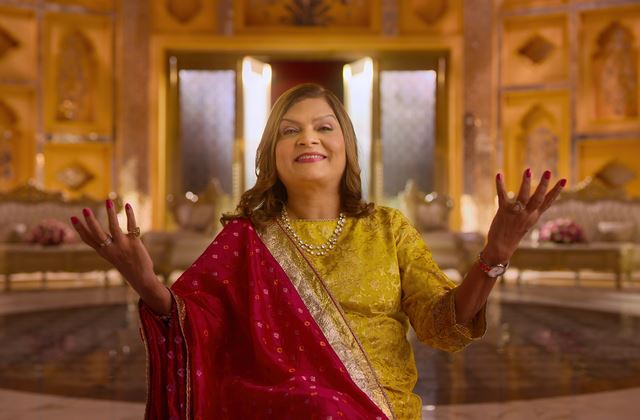By Shree Baphna
Sima Taparia from Indian Matchmaking gives an insight into her process ahead of the show’s upcoming third season.
On a Thursday morning, I sat in front of my laptop, eagerly waiting for a screen labeled “Sima” to pop up into my Zoom session. I rehearsed in my head what I was going to say to her as a greeting. Should I try to impress her with my accented Hindi? Should I say “namaste” when I greet her? Would she ask me about my ‘marital status?’
Before I could think any further, Sima’s smiling face appeared, and I quickly gathered myself to begin our short chat.
Yes, in case you are wondering, I had the absolute pleasure of interviewing Sima Taparia from Netflix’s hit reality series Indian Matchmaking. Ahead of the show’s third season, AsAmNews wanted to get an insight into the eccentric matchmaker’s persona and her ability to find what is evasive for many- our one true love.
As you might have gathered at this point, I am a huge fan of the show. My family and I, being from India, are completely awestruck by the sheer popularity of the show in the Western world. Matchmaking is all too familiar to us. To see something Indians were once ridiculed for now a part of mainstream pop culture leaves us with mixed feelings. But we are nonetheless elated to be represented on a big platform like Netflix.
Sima’s bubbly personality was evident from the moment she switched her camera on. This was my first time interviewing a celebrity, so to speak, but when I saw her, I immediately felt like I was having a chat with a familiar and endearing auntie from back home.
I greeted her with a traditional “Namaste, Simaji” (just as I had rehearsed in my head). Sima’s personality is exactly like what you see on the show- frank, but loving and curious at the same time. She immediately began quizzing me about my family background and where in India we were from.
I could have gone on, but with great effort, I steered us to the questions I had on hand. I offered for Simaji to speak in either English or Hindi, depending on her comfort, but was met with a scoff and a playful lament: “Everyone wants English these days! But I love speaking in Hindi, I have more fun and can express my emotions better!”.
Of course, I wanted to impress her, so I profusely agreed (even though my Hindi leaves a lot to be desired).
Sima is clearly a people’s person. She has a unique ability to connect with others around her. Her love and talent for matchmaking first became apparent when she matched her sister, Preethi, with her now-husband. The two are happily married and live in Boston. It was this particular accomplishment that got her thinking about the prospects of turning this into a full-time profession. Sima knew she had the necessary skills. Aside from being outgoing and social, she was also adept at creating rishtas, or relationships with others. Maintaining such a wide network is no small feat, but for Sima, it was effortless. She decided to officially turn matchmaking into her profession 2005 and has not looked back since.
After the first season of Indian Matchmaking premiered- and to huge success- Sima’s business skyrocketed.
“Every second there was a phone call”, Sima said. “I even had to unplug my landline for two months!”.
For Sima, the fame and recognition are by-products of being able to do what she loved- help people find their life partners through traditional matchmaking processes. Sima’s business is especially unique because of the human touch and emotion she brings to it. For Sima, her clients are like her own children. She brings goodwill to her work and wants nothing but the best for her clients. However, Sima noticed it was specifically her traditional Indian matchmaking methods that won her audience over.
“People love these traditional Indian values. I am a lady with traditional Indian values. Unfortunately, these values are disappearing”, Sima states.
What is interesting is how younger generations are now clamoring for these ‘traditional values’ and are breathing new life into them, especially through matchmaking. For many of the younger generation, these values are a bridge to connect with their Indian roots. This is what makes the show so unique, according to Sima. It is this portrayal of ancient custom against the backdrop of the 21st century, which has won Indian Matchmaking its popularity.

I mentioned to Sima how I too wish to re-connect with my roots. As a South Asian immigrant, it is sometimes hard to remain emotionally and physically connected with one’s native country. Curious to know more about how such immigrant identities played into one’s matchmaking journey, I quizzed Sima on the differences between her clients in India versus her clients in the US.
“Clients in the US are very indecisive, I am sorry to say”, Sima says. In the US, as per dating norms, people often stay in a relationship for some time while before deciding it is not right for them. In India, this is not the case. Sima gives her clients in India a time limit within which to decide whether or not they wanted to formalize their relationship.
According to Sima, the logic is simple.
“If you do not decide in five years, you will not decide your whole life!”, she exclaims. For Sima, matchmaking as a process is more black and white than what clients perceive it to be. This is perhaps where cultural difference between India and the US show up. Dating culture in the Western world is very much the norm, whereas in India this is not the case.
Sima went on to say that her clients in India place a little more value on family background and physical appearances as compared to her US clients. However, both sets place enormous importance on education and wanting to be matched with someone who is educated to the same level. Despite these basic ground rules, many clients still find it hard to decide on a match. This is where Sima’s teaching comes in.
“No two people are the same, so why should anyone ever ‘match’ you? Here is where I will tell you the guru mantra- you will never get 100%. If you meet someone who fulfills 60% of your criteria, then go and take the relationship forward!”.
From Sima’s words, it is clear that matchmaking is not some magical act that will simply extract the perfect partner for someone. Rather, it is a process of compromise for both parties. One must be realistic about who they find compatibility with and not close themselves off to opportunities simply because one or two desired qualities are absent.
This is, in fact, how matchmaking has changed back from when Sima first started in 2005. Younger generations entering the marriage stream are now older, are more financially independent, are more educated than before, and are focused on what they want in a partner. But, according to Sima, this has led to unrealistic expectations in younger generations today because they want “100% of their criteria to be met”. It is a simple matter of being willing to ‘adjust’, as Sima has famously stated time and again on her show. Flexibility is key in making a relationship work. People are not automatically suited for one another but grow to accommodate one another’s personalities and quirks.
I remember when I watched the first season, there was a lot of debate around Sima’s mantra of ‘adjusting’ and how it applied differently to men and women (in the binary sense) in the matchmaking process. This has been a debate among fans- at least in my circle of family and friends- for a long time. Unsurprisingly, the desire to maintain traditional roots has clashed with modernized thought processes in younger generations.
I decided to get Sima’s take on this. I was curious to know from her perspective what she thought of matchmaking as a process that often favored men over women. Hand-in-hand with matchmaking, many traditional wedding ceremonies are sexist in nature. One particular ceremony is the kanyadaan, or the Indian equivalent to ‘giving the bride away’. Many brides in younger generations are opting not to do a kanyadaan for this reason.

To Sima, however, this angle of sexist practices stems from not knowing the true meaning and intent behind these age-old traditions. These ceremonies are simply rituals passed down from generation to generation and are nothing new. From Sima’s perspective, labeling a process likely matchmaking or a ritual like kanyadaan as sexist is very reductive. It fails to recognize the fact that such rituals are meant more to bestow divine blessings from a higher-up. It is not meant to be anything more sinister than that.
As someone who has been skeptical of Indian traditions because they are more male-centric, I wanted to know from Sima where younger generations could go to educate themselves more about these customs. For Sima, the ultimate resource is the elders in one’s family.
“They have lived long and experienced a lot”, Sima says. “They have the information we need”.
However, according to Sima, younger generations are often stuck in their adamant disdain for others telling them what to do.
“Drop your ego and keep your patience”, Sima advises. This is the key to learning more about yourself, about the kind of partner you are, and to understand the person we want to spend the rest of our life with.
Even though I may not be entirely convinced by matchmaking as a traditional process, I nevertheless remain a huge fan of the show. Sima’s passion and energy is infectious. At the end of the day, anyone who helps others find their lifetime companion is certainly doing many a huge service!
AsAmNews is incorporated in the state of California as Asian American Media, Inc, a non-profit with 501c3 status. We are currently funded by our readers and the California Library Commission’s Stop The Hate program under the State Dept of Social Services. See their funded resources for direct, prevention and intervention services here. Find additional content from AsAmNews on Instagram , Twitter, Tiktok and Facebook. Please consider interning, joining our staff, or submitting a story, or making a tax-deductible donation.



